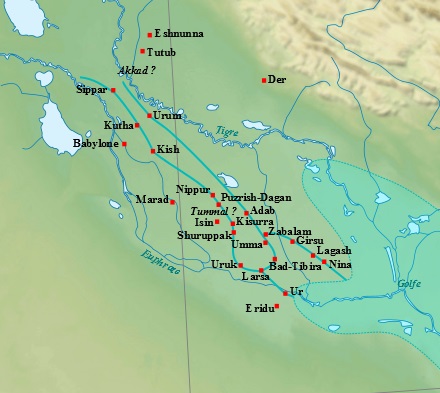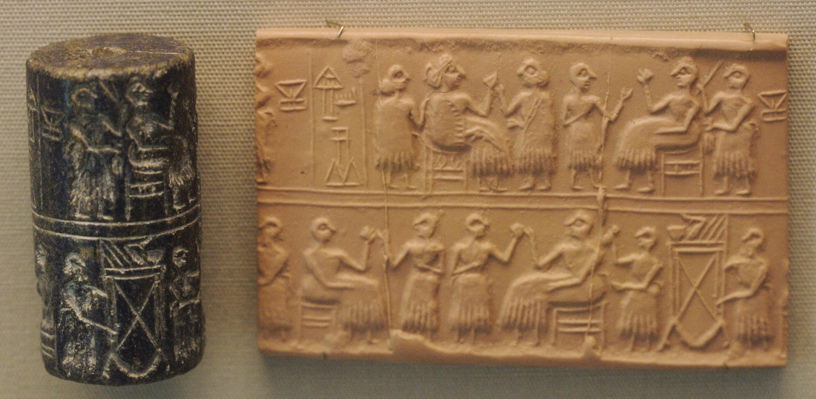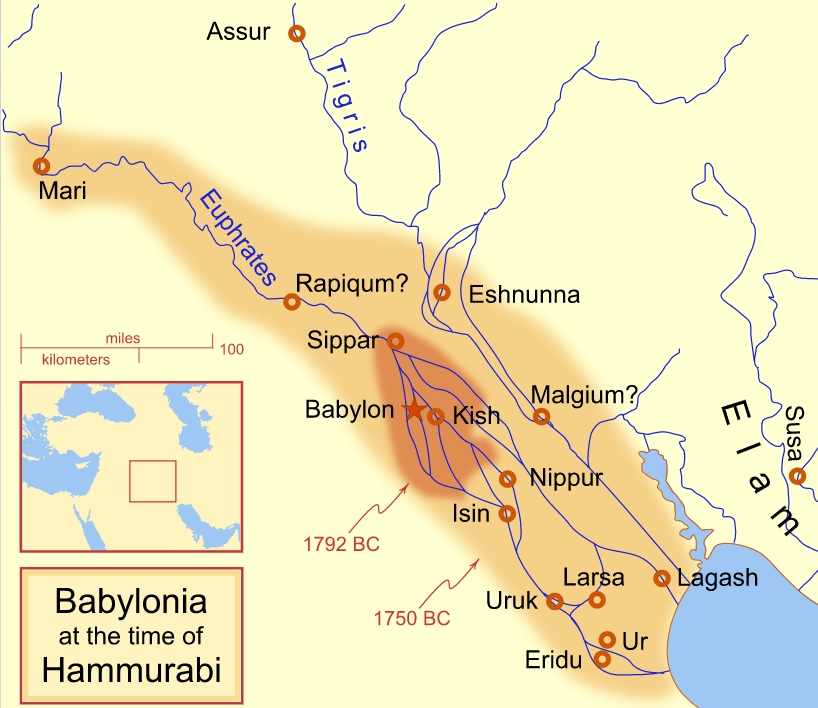Sumerians are known as the founders of the urban civilization that dominated in southern Mesopotamia in the 4th and 3rd millennia BC. They developed a network of irrigation channels that made it possible to cultivate cereals in desert areas of the Lower Euphrates, introduced an ideographic script, initially pictographic and then simplified to the form of cuneiform characters impressed in wet clay, built the biggest cities in the world at that time, with monumental temples and enormous palaces.

Near_East_topographic_map-blank.svg: Sémhur(published under CC BY-SA 3.0, via Wikimedia Commons)
Sumerian civilization…
From the very beginning the Sumerian civilization was attractive to its neighbours, which is reflected in the adaptation of the cuneiform script to other languages (Akkadian, Hittite, Elamite) and the diffusion of the Sumerian city-state system into other regions of the Near East. Probably from the very beginning, Sumerians shared southern Mesopotamia with Akkadians, who inhabited the area of later Babylonia (vicinity of modern Baghdad), and there is a number of arguments suggesting that already in the mid-3rd millennium BC most of the population of Sumer used the Akkadian language on a daily basis. Nevertheless, the Sumerian language was still commonly used in writing at the beginning of the 2nd millennium, not only in religious texts (including the famous Epic of Gilgamesh), but also in many economic documents. Both the Akkadians living in southern Mesopotamia since time immemorial and the Amorites, who took it over in the late 21st century BC and used Semitic languages, preserved the Sumerian language as a language of elites, just like Latin that was the language of elites in Europe not long ago.

© Nic McPhee from Morris (published under CC BY-SA 2.0, via Wikimedia Commons)
Together with the language, other essential elements of the Sumerian civilization were preserved until the beginning of the 2nd millennium BC: firstly, the division of the irrigation network into segments controlled by different city-states, which despite several episodes of unions (Akkadian Empire in 24th/23rd century, the state of the Third Dynasty of Ur in 21st century BC), were the core of social organization in southern Mesopotamia, secondly, the specific socio-religious system that laid the foundations for efficient functioning of the state, treating the ruler as an intermediary between the gods and the people, above all responsible for abundant harvest, thirdly, the bureaucratic system, thanks to which the central administration controlled agricultural production and redistribution of food.
… and its end in the 2nd millennium BC
However, already in the mid-2nd millennium BC, when a big part of southern Mesopotamia belonged to the Babylonian state, initially ruled by the Amorite dynasty, with Hammurabi as its best known member, and then by Kassites, who previously formed a small state in the valley of the Middle Euphrates, these most important elements of the Sumerian civilization were no longer present. Instead of city-states with separate administration structures there is a centralized territorial state. The king is no longer the trusted representative and administrator of the property of the god, but rather a judge dealing with the affairs of his subjects, himself living in fear of punishment sent by gods. The Sumerian language is familiar to a decreasing number of priests, who have no idea of the original context of old myths and religious texts and, therefore, interpret them with numerology and esoteric associations.
Historians of ancient Mesopotamia generally represent this disappearance of Sumerian civilization patterns as a gradual process, initiated by the Akkadians in the late 3rd millennium, then continued by the Amorites in the early 2nd millennium and completed by the Kassites in the mid-2nd millennium BC. Nevertheless, there are certain important arguments suggesting that the fall of the Sumerian civilization was not a slow process, but a rapid change of catastrophic nature, which took place in the 11th regal year of Samsu-iluna, the son and successor of Hammurabi to the throne of Babylon, ruling in approx. 1749-1712 BC.
Old Babylonian state
In the late 21st century BC, when the state of the Third Dynasty of Ur declined, the southern and central Mesopotamia was divided into several Amorite states, the strongest of which had capitals in the cities of Isin and Larsa, hence 20th and 19th centuries BC are called the Isin-Larsa period. In the middle of this period Babylon was a small kingdom ruled by the Amorite dynasty founded by a ruler called Sumu-abum (approx. 1894-1881 BC), whose successors dominated central Mesopotamia (from then on called Babylonia) within the next century, and finally Hammurabi (approx. 1792-1750 BC) established a kingdom including a big portion of the former state of the Third Dynasty of Ur.

MapMaster (published under CC BY-SA 4.0, via Wikimedia Commons)
Rebellion of Sumerian cities
Hammurabi maintained the existing administrative model, in which the conquered cities of southern Mesopotamia, regarded as dominions of different gods of the Sumerian pantheon, preserved certain autonomy in the management of local resources, but had to pay taxes to the Babylonian king. This generated tensions that led to a civil war between Babylon and usurping rulers of Larsa and Uruk in the 8th regal year of Samsu-iluna (1742 BC). The rebellious cities were supported by other Sumerian cities as their revolt gave rise to a hope of return to the model in which the city-states were totally independent. The war lasted four years and ended with the victory of the Babylonian king, but it was a Pyrrhic victory.
The progress of the war can be reconstructed on the basis of many dated documents from that period. Larsa rebelled in the twelfth month of the 7th year of Samsu-iluna’s reign and other Sumerian cities joined the opposition from the first to the seventh month of the 8th years of his reign. In the eighth month Uruk revolted as the last one. Samsu-iluna suppressed parallel rebellions in the northern part of the Babylonian state throughout his 9th regal year, and then started pacification of the Sumerian cities. First, at the beginning of the 10th year of his reign, he regained Larsa, and then, by the end of the year, he captured other cities as far as Lagash, located in the southeast.
Although the revolt was over and Samsu-iluna took control of the rebellious cities, Sumer disappeared from the map of the Babylonian state soon after the end of the war. The last known texts from the majority of south Mesopotamian cities are dated to the 10th or 11th year of Samsu-iluna’s reign (approx. 1739 BC). Only the cities of Nippur and Isin, located in the northern part of Sumer, survived more than ten years longer and were finally abandoned in approx. 1720 BC.
Foundation of the Sealand
A big portion of southern Mesopotamia was incorporated into a state called the Sealand, whose first ruler, Iluma-ili, is attested in several texts from Nippur from the last years of the existence of the city. For this reason, some historians of ancient Mesopotamia conclude that the Sumerian cities were simply taken over by the dynasty. However, the results of archaeological research at many sites leave no room for doubt that most Sumerian cities were abandoned for several centuries and the Sealand was rather a sparsely populated area, situated mainly in the area of the marshes around the northern coast of the Persian Gulf. Only the Kassites, who took over the power in Babylonia in the early 16th century BC and defeated the dynasty of the Sealand in the mid-15th century, rebuilt some of the cities abandoned in the times of Samsu-iluna, above all Nippur, which was previously the main religious centre of Sumer.

© Hassan Janali, U.S. Army Corps of Engineers – U.S. Army Corps of Engineers, Public Domain
Considerable amount of data suggests that the kings of the Sealand tried to support the declining Sumerian civilization, which is evidenced not only by the Sumerian names of some of them, but also by administrative texts found at the site of Tell Khabeir near Ur, documenting the continuation of the traditional economy exploiting the local irrigation network.
Change in the course of the Euphrates River
Texts from the reign of Samsu-iluna do not account for the cause of abandonment of most Sumerian cities, but the analysis of changes in the settlement network suggests that the main bed of the Euphrates River moved significantly at that time. Since southern Mesopotamia is completely flat and the accumulation of the sediments carried by water leads to a gradual elevation of the riverbed if it is not systematically cleaned, the Euphrates changed its course many times in the past. Nevertheless, it is likely that under Samsu-iluna the river irreversibly moved several hundred kilometres west in the area between Babylon and Ur near the Persian Gulf. This resulted in complete drying of the majority of irrigation channels and, consequently, the fall of the economy of the cities that used these channels. The places which did not suffer this change were the area around Babylon and a small enclave near the mouth of the Euphrates in the vicinity of the Persian Gulf, which later probably became the centre of the Sealand.

R. W. Rogers, 1915, A history of Babylonia and Assyria, Abingdon Press, Public Domain
The contribution of humans to this ecological disaster is unclear. It could have been caused by neglect of the irrigation network, which required systematic cleaning, or by conscious actions of Samsu-iluna, who could take advantage of the change in the course of the river and cutting off the supply of water to Sumerian cities, and thus suppress the rebellion in these provinces more easily. There are written sources suggesting that earlier kings of Babylon blocked the irrigation channels supplying water to Larsa and after conquering the city restored them to proper function. If the change in the course of the whole Euphrates was an intentional action initiated by Samsu-iluna, it might have proved irreversible due to its scale.
After the disaster…
The consequences for the local population must have been dramatic, although documentation of the period after the fall of Sumer is very fragmentary. The inhabitants of the cities deprived of water definitely needed to leave them in a hurry. The administration of the Babylonian state provided at least partial systematic relocation of the population: the refugees from Uruk moved to Kish, from Larsa to Babylon, and from Isin to Sippar. There are certain arguments suggesting that the temple staff from Nippur were relocated to Babylon, where the cult of the main Sumerian gods was continued. The immigrants from the Sumerian cities preserved their identity for a generation or two, but they were eventually assimilated by the Babylonian population. When the kings of the Kassite dynasty conquered the Sealand and launched a partial restoration of the irrigation network in the area of former Sumer, the foundations of the Sumerian civilization, just like the Sumerian language, had been dead for at least a few generations.
Irrespective the change in the course of the Euphrates River was a natural disaster, or intentional or accidental human activity contributed to it, it can be regarded as the most important dividing line in the history of southern Mesopotamia. Its consequence was a significant change in the social and political organization, as well as in the economy. It is a historical irony that the Euphrates, the mother-river without which the Sumerian civilization would not have developed at all, also led to its rapid fall.
= = =
The events from reign of Samsu-iluna were the subject of doctoral dissertation by Harold T. Vegeler (Yale).
This article may be freely reprinted with photographs, with reference to the source
Author: Arkadiusz Sołtysiak
Translation: Barbara Majchrzak
